Abstract
Oral exposures of nonoccupational populations to environmental inorganic arsenic are associated with skin and internal cancers as well as various noncarcinogenic effects. Cancer risk assessments have been based largely on epidemiological studies of a large population exposed to inorganic arsenic in well water in Taiwan. Criticisms and skepticism of the use of the Taiwanese data for estimating arsenic cancer risks outside of Taiwan, including potential use by the U.S. Environmental Protection Agency for regulatory purposes, have been expressed on various grounds. The nature and extent of such criticisms have sharpened with recent findings in the exposed Taiwanese of increased incidence of internal cancers (bladder, kidney, liver, and lung), in addition to already-observed skin cancer, coupled with a good likelihood that these findings will produce more stringent arsenic regulation in the United States and elsewhere. These criticisms collectively posit a revisionist view that: 1) cancer incidence among the Taiwanese was amplified by a number of host and environmental factors not applicable elsewhere, 2) the cancer dose-response curve may not be linear at the lower exposures elsewhere, and 3) there is a toxicokinetic and metabolic threshold to cancer risk that was exceeded by the Taiwanese. However, a number of the arguments against wide use of the Taiwanese data are flawed and subject to challenge. We explore some of these arguments and their critical evaluation, particularly as they concern certain exposure, metabolic, and nutritional determinants of the cancer risk of inorganic arsenic in the Taiwanese.
Full text
PDF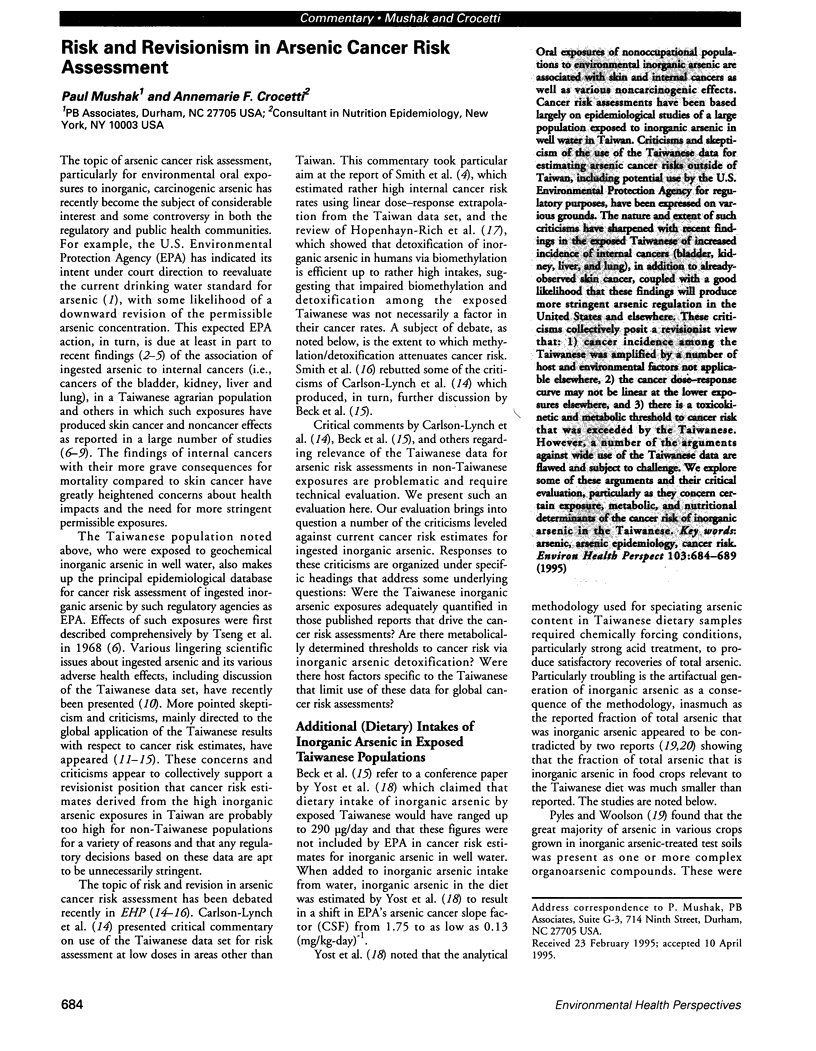
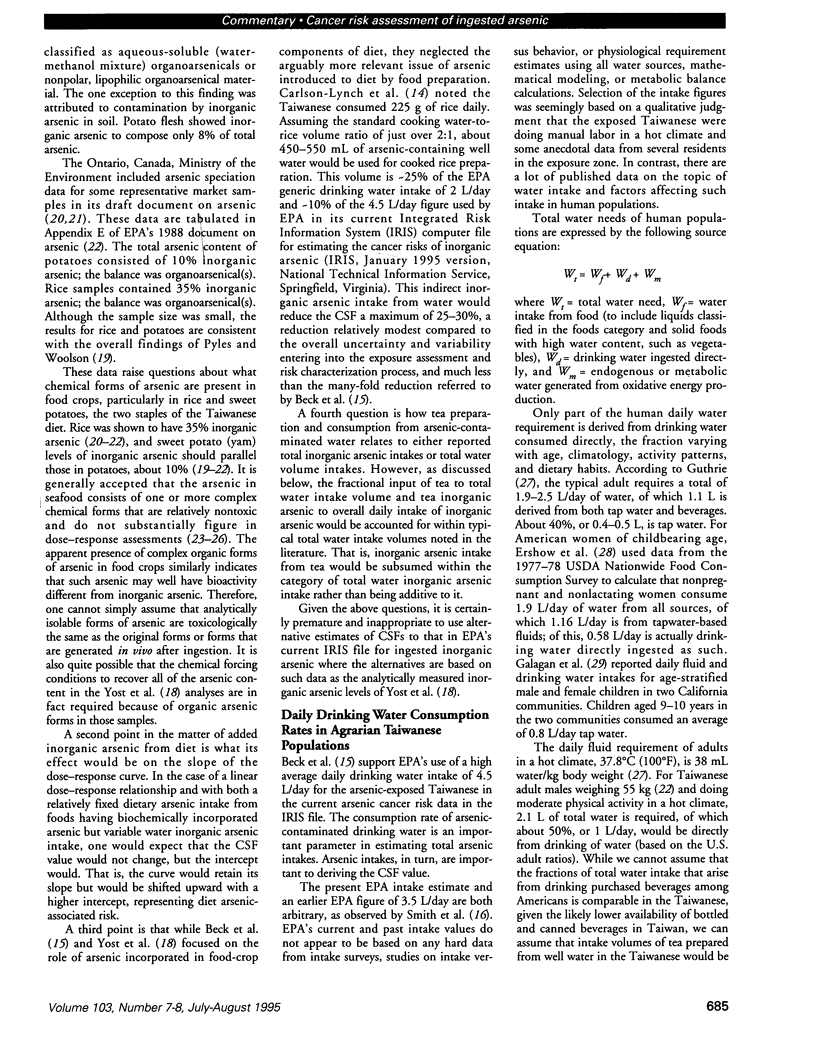
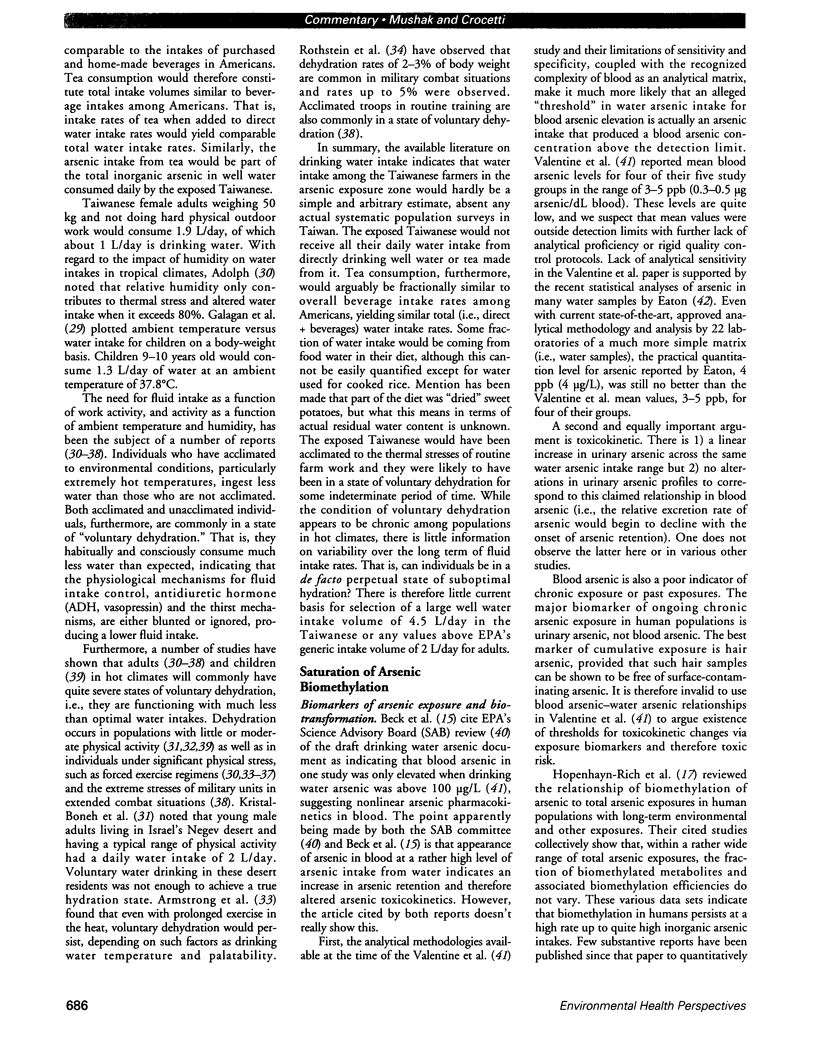
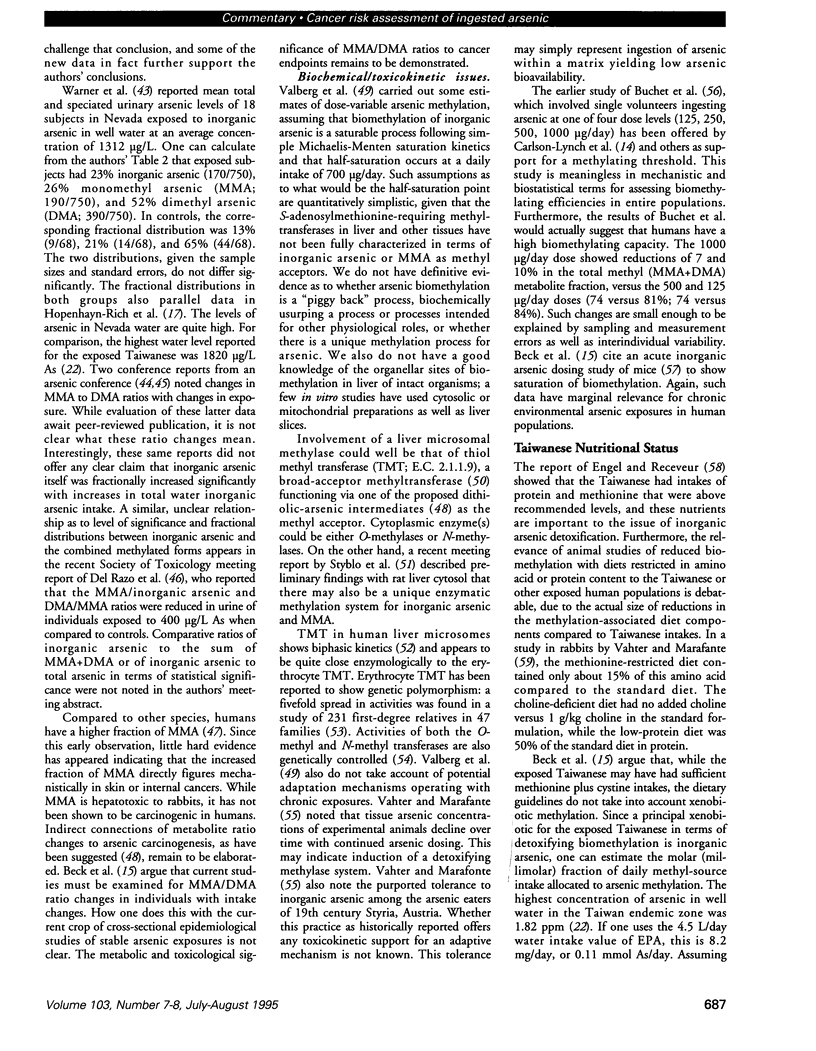
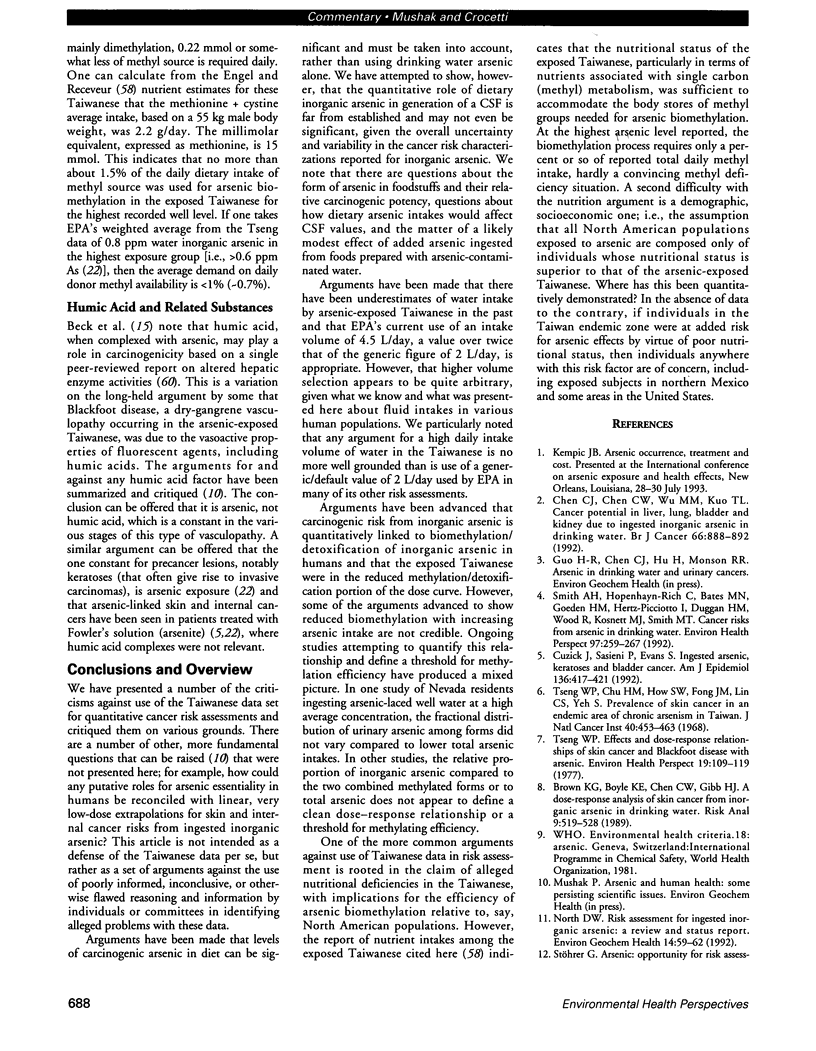
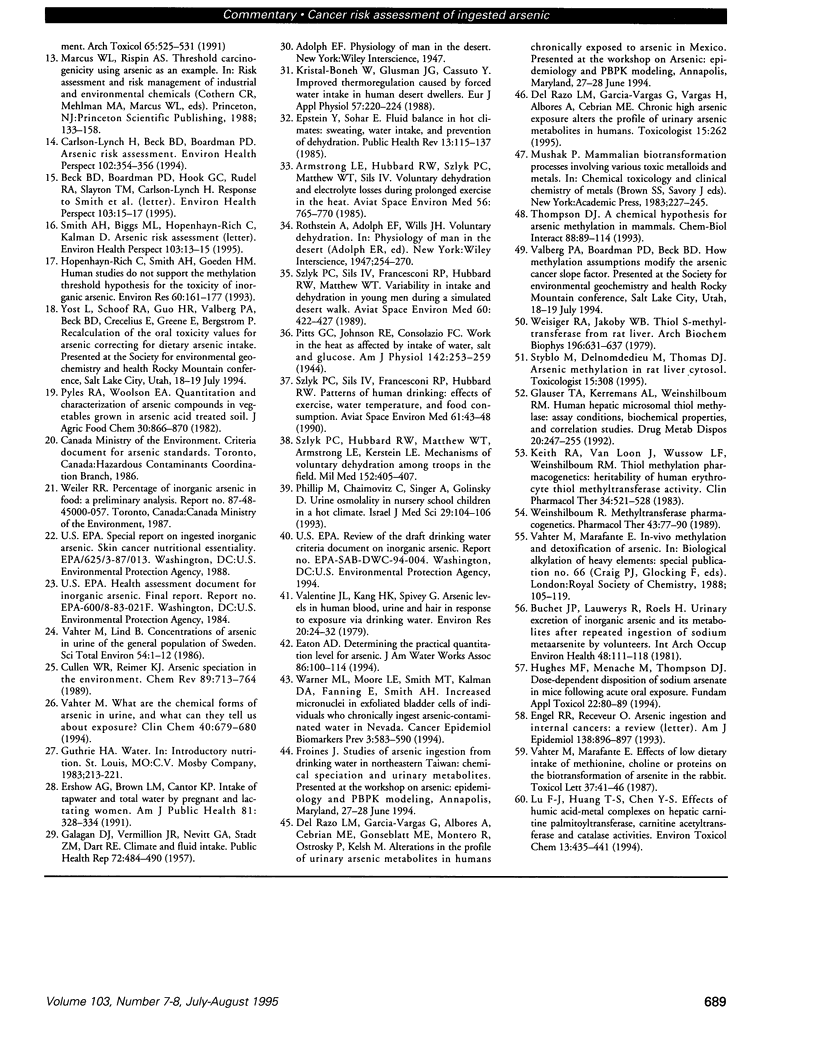
Selected References
These references are in PubMed. This may not be the complete list of references from this article.
- Armstrong L. E., Hubbard R. W., Szlyk P. C., Matthew W. T., Sils I. V. Voluntary dehydration and electrolyte losses during prolonged exercise in the heat. Aviat Space Environ Med. 1985 Aug;56(8):765–770. [PubMed] [Google Scholar]
- Brown K. G., Boyle K. E., Chen C. W., Gibb H. J. A dose-response analysis of skin cancer from inorganic arsenic in drinking water. Risk Anal. 1989 Dec;9(4):519–528. doi: 10.1111/j.1539-6924.1989.tb01263.x. [DOI] [PubMed] [Google Scholar]
- Buchet J. P., Lauwerys R., Roels H. Urinary excretion of inorganic arsenic and its metabolites after repeated ingestion of sodium metaarsenite by volunteers. Int Arch Occup Environ Health. 1981;48(2):111–118. doi: 10.1007/BF00378431. [DOI] [PubMed] [Google Scholar]
- Carlson-Lynch H., Beck B. D., Boardman P. D. Arsenic risk assessment. Environ Health Perspect. 1994 Apr;102(4):354–356. doi: 10.1289/ehp.94102354. [DOI] [PMC free article] [PubMed] [Google Scholar]
- Chen C. J., Chen C. W., Wu M. M., Kuo T. L. Cancer potential in liver, lung, bladder and kidney due to ingested inorganic arsenic in drinking water. Br J Cancer. 1992 Nov;66(5):888–892. doi: 10.1038/bjc.1992.380. [DOI] [PMC free article] [PubMed] [Google Scholar]
- Cuzick J., Sasieni P., Evans S. Ingested arsenic, keratoses, and bladder cancer. Am J Epidemiol. 1992 Aug 15;136(4):417–421. doi: 10.1093/oxfordjournals.aje.a116514. [DOI] [PubMed] [Google Scholar]
- Engel R. R., Receveur O. Re: "Arsenic ingestion and internal cancers: a review". Am J Epidemiol. 1993 Nov 15;138(10):896–897. doi: 10.1093/oxfordjournals.aje.a116797. [DOI] [PubMed] [Google Scholar]
- Epstein Y., Sohar E. Fluid balance in hot climates: sweating, water intake, and prevention of dehydration. Public Health Rev. 1985;13(1-2):115–137. [PubMed] [Google Scholar]
- Ershow A. G., Brown L. M., Cantor K. P. Intake of tapwater and total water by pregnant and lactating women. Am J Public Health. 1991 Mar;81(3):328–334. doi: 10.2105/ajph.81.3.328. [DOI] [PMC free article] [PubMed] [Google Scholar]
- GALAGAN D. J., VERMILLION J. R., NEVITT G. A., STADT Z. M., DART R. E. Climate and fluid intake. Public Health Rep. 1957 Jun;72(6):484–490. [PMC free article] [PubMed] [Google Scholar]
- Glauser T. A., Kerremans A. L., Weinshilboum R. M. Human hepatic microsomal thiol methyltransferase. Assay conditions, biochemical properties, and correlation studies. Drug Metab Dispos. 1992 Mar-Apr;20(2):247–255. [PubMed] [Google Scholar]
- Hopenhayn-Rich C., Smith A. H., Goeden H. M. Human studies do not support the methylation threshold hypothesis for the toxicity of inorganic arsenic. Environ Res. 1993 Feb;60(2):161–177. doi: 10.1006/enrs.1993.1024. [DOI] [PubMed] [Google Scholar]
- Hughes M. F., Menache M., Thompson D. J. Dose-dependent disposition of sodium arsenate in mice following acute oral exposure. Fundam Appl Toxicol. 1994 Jan;22(1):80–89. doi: 10.1006/faat.1994.1011. [DOI] [PubMed] [Google Scholar]
- Keith R. A., Van Loon J., Wussow L. F., Weinshilboum R. M. Thiol methylation pharmacogenetics: heritability of human erythrocyte thiol methyltransferase activity. Clin Pharmacol Ther. 1983 Oct;34(4):521–528. doi: 10.1038/clpt.1983.208. [DOI] [PubMed] [Google Scholar]
- Kelser R. A. Methods of Exposing Experimental Animals to Virus Infection Through Mosquito Vectors. Am J Public Health Nations Health. 1940 Aug;30(8):866–870. doi: 10.2105/ajph.30.8.866. [DOI] [PMC free article] [PubMed] [Google Scholar]
- Kristal-Boneh E., Glusman J. G., Chaemovitz C., Cassuto Y. Improved thermoregulation caused by forced water intake in human desert dwellers. Eur J Appl Physiol Occup Physiol. 1988;57(2):220–224. doi: 10.1007/BF00640666. [DOI] [PubMed] [Google Scholar]
- Philip M., Chaimovitz C., Singer A., Golinsky D. Urine osmolality in nursery school children in a hot climate. Isr J Med Sci. 1993 Feb-Mar;29(2-3):104–106. [PubMed] [Google Scholar]
- Smith A. H., Biggs M. L., Hopenhayn-Rich C., Kalman D. Arsenic risk assessment. Environ Health Perspect. 1995 Jan;103(1):13–17. doi: 10.1289/ehp.9510313b. [DOI] [PMC free article] [PubMed] [Google Scholar]
- Smith A. H., Hopenhayn-Rich C., Bates M. N., Goeden H. M., Hertz-Picciotto I., Duggan H. M., Wood R., Kosnett M. J., Smith M. T. Cancer risks from arsenic in drinking water. Environ Health Perspect. 1992 Jul;97:259–267. doi: 10.1289/ehp.9297259. [DOI] [PMC free article] [PubMed] [Google Scholar]
- Szlyk P. C., Sils I. V., Francesconi R. P., Hubbard R. W., Matthew W. T. Variability in intake and dehydration in young men during a simulated desert walk. Aviat Space Environ Med. 1989 May;60(5):422–427. [PubMed] [Google Scholar]
- Szlyk P. C., Sils I. V., Francesconi R. P., Hubbard R. W. Patterns of human drinking: effects of exercise, water temperature, and food consumption. Aviat Space Environ Med. 1990 Jan;61(1):43–48. [PubMed] [Google Scholar]
- Thompson D. J. A chemical hypothesis for arsenic methylation in mammals. Chem Biol Interact. 1993 Sep;88(2-3):89–14. doi: 10.1016/0009-2797(93)90086-e. [DOI] [PubMed] [Google Scholar]
- Tseng W. P., Chu H. M., How S. W., Fong J. M., Lin C. S., Yeh S. Prevalence of skin cancer in an endemic area of chronic arsenicism in Taiwan. J Natl Cancer Inst. 1968 Mar;40(3):453–463. [PubMed] [Google Scholar]
- Tseng W. P. Effects and dose--response relationships of skin cancer and blackfoot disease with arsenic. Environ Health Perspect. 1977 Aug;19:109–119. doi: 10.1289/ehp.7719109. [DOI] [PMC free article] [PubMed] [Google Scholar]
- Vahter M., Lind B. Concentrations of arsenic in urine of the general population in Sweden. Sci Total Environ. 1986 Oct;54:1–12. doi: 10.1016/0048-9697(86)90252-4. [DOI] [PubMed] [Google Scholar]
- Vahter M., Marafante E. Effects of low dietary intake of methionine, choline or proteins on the biotransformation of arsenite in the rabbit. Toxicol Lett. 1987 Jun;37(1):41–46. doi: 10.1016/0378-4274(87)90165-2. [DOI] [PubMed] [Google Scholar]
- Vahter M. What are the chemical forms of arsenic in urine, and what can they tell us about exposure? Clin Chem. 1994 May;40(5):679–680. [PubMed] [Google Scholar]
- Valentine J. L., Kang H. K., Spivey G. Arsenic levels in human blood, urine, and hair in response to exposure via drinking water. Environ Res. 1979 Oct;20(1):24–32. doi: 10.1016/0013-9351(79)90082-3. [DOI] [PubMed] [Google Scholar]
- Warner M. L., Moore L. E., Smith M. T., Kalman D. A., Fanning E., Smith A. H. Increased micronuclei in exfoliated bladder cells of individuals who chronically ingest arsenic-contaminated water in Nevada. Cancer Epidemiol Biomarkers Prev. 1994 Oct-Nov;3(7):583–590. [PubMed] [Google Scholar]
- Weinshilboum R. Methyltransferase pharmacogenetics. Pharmacol Ther. 1989;43(1):77–90. doi: 10.1016/0163-7258(89)90048-x. [DOI] [PubMed] [Google Scholar]
- Weisiger R. A., Jakoby W. B. Thiol S-methyltransferase from rat liver. Arch Biochem Biophys. 1979 Sep;196(2):631–637. doi: 10.1016/0003-9861(79)90317-5. [DOI] [PubMed] [Google Scholar]


